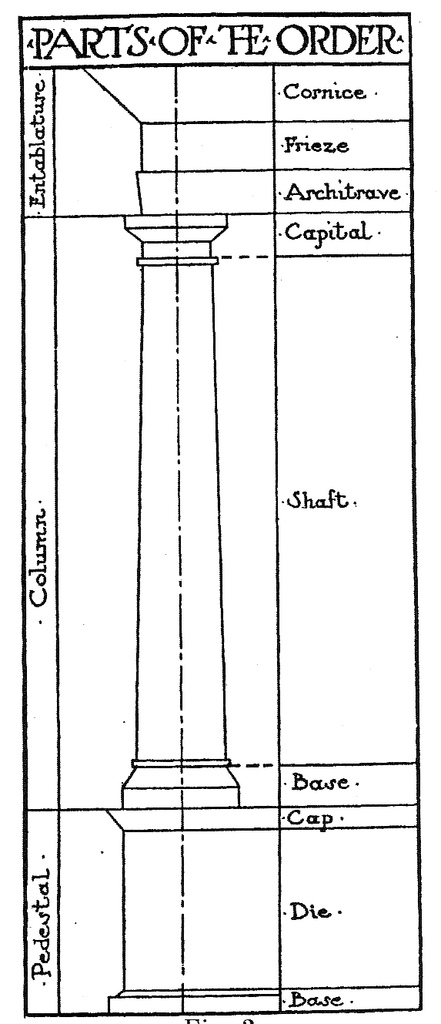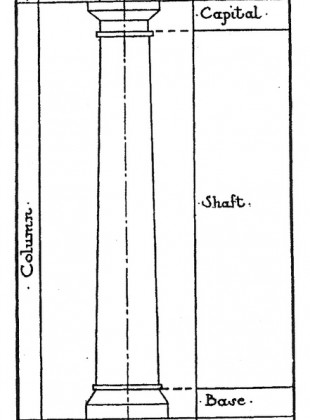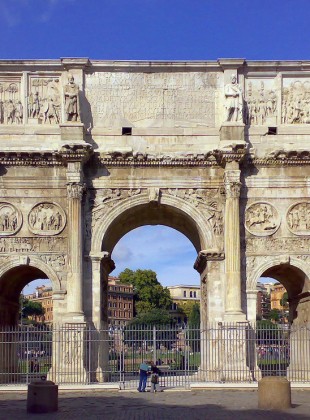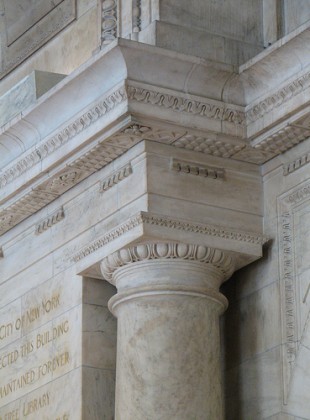Let’s spend a little time talking about the orders, the names of the parts, and how they are put together. It’s much easier to talk about architecture when you have names for things. Once you develop a vocabulary, you will notice subtleties that you had not seen before. And while there is much to traditional architecture apart from the orders, they are the principal ornament since their subject is structure, and they are almost always present even if only by implication. This is true for all traditional styles, from Greek to Roman to Gothic to Queen Anne.
This diagram, from Frank Chouteau Brown’s classic text The Study of the Orders, describes the major parts:
Notice how the full order is divided into three parts (pedestal, column, entablature), and that each part is itself divided into three. The pedestal is divided into base, die, and cap; the column is divided into base, shaft, and capital; and the entablature (the beam) is divided into architrave, frieze, and cornice. Why three parts and not four or two? Well, Aristotle states in his Poetics (Section 1, Part VII), speaking of the structure of a plot, that a whole must have a beginning, a middle, and an end. Common sense, right? What is true for a plot is also true for architecture (as well as music, and poetry), though here we speak about a bottom, a middle, and a top. In the order taken as a whole, the pedestal starts things off by mediating with the ground, the column travels upwards, and the entablature caps things off, mediating with the sky. Each part of the order is also a whole unto itself, with a bottom, a middle, and a top.

The Arch of Constantine
(Image Source)
In the Arch of Constantine, above, the Corinthian order is fully expressed. (The element above the entablature is called an attic story.) However, the orders can also be present by implication. How is this possible? Well, you don’t always want to show the order fully expressed. Normally, full expression signifies high status, so if you have a low status building, you simply omit some of the parts. Not every construction is as important as a triumphal arch. You might show no pedestal, and perhaps no column (leaving only a wall). And if it were truly a humble pile, you might omit the architrave and frieze of the entablature leaving only a cornice that itself had very little detail. Here is a row of small houses on the isle of Burano, near Venice, with a simple block cornice. One could easily sketch over top of this photo a fully developed Ionic order, adding frieze and architrave to the existing cornice for a complete entablature, with column and pedestal below.

Burano, near Venice, Italy
(Image Source)
The cornice is perhaps the most important part of the order as it is almost always the last piece to be omitted. The example below from the New York Public Library entry hall shows the frieze omitted so the cornice sits directly on top of the architrave. The architects (Carrère and Hastings) have been clever here as the top part of the architrave, the band with the little guttae hanging below, is actually doing double duty, standing in for the lower part of the cornice (called a bed mold). This overlapping of elements, which can happen at any scale, is called elision.
It takes experience and a good working knowledge of architectural history to know when to omit and how to do it. But before that it takes vocabulary so one can understand the pieces one is working with. One ought to be so equipped such that one could instruct a draftsman over the telephone, describing a building down to the last detail. Since each element is a whole unto itself, each has its own history and its own character. A building is like a symphony: before you can compose one, you have to understand each instrument in the orchestra.
More on this in future posts.








I’m just an interested layman. The idea, even the name “orders” seem to put us modern “sophisticates” off. What is it about the orders that make them archetypal?
I think what makes them so archetypal is that they idealize structure so well. They speak with clarity and refinement, and they offer a full range of expression, hence they have managed to survive 2,500 years. The ancient Greeks, in their brilliance, did this to everything they touched, from architecture to sculpture to philosophy. We have been living off their cultural capital ever since. Unfortunately, modern man cannot stand the idea that he might learn something from previous generations.
“They speak with clarity and refinement, and they offer a full range of expression…” I’m all for that but it’s a tough sell to my children in their low 20’s. They’d recognize something special but… I’d look for counterparts in the asia to make the case for universality. I’d guess the best of Angkor Watt exhibits the Greek ideas. Japanese architecture too. Anyway I guess it an uphill struggle worth engaging.P.S. I followed your Tweet about Denis McNamara. Excellent. Best video art history since Kenneth Clark’s Civilization.
The strange thing about universals is you don't find them everywhere.
Thanks for that explanation. It provided a unique insight into the divisions and why they are that way. I have never read such an insightful explanation, instead of just naming the parts.